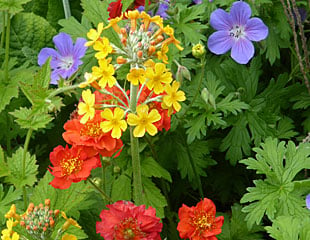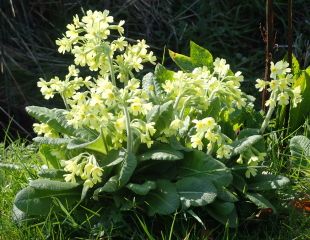
Primula veris

Primula beesiana

Primula denticulata
How To Grow Primula
Key Points:
Height: Primula are a complex genus, with many botanical groups, but those widely grown are: Auricula 10-30 cm, Candelabra .5-1m, Polyanthus/Primrose group 15-20 cms.
Light: all will grow in the sun, although a slightly shady, cooler area is better.
Soil Candelabra are best in moist soils and wetter areas, Primula and Auricula any soil, well-drained and reasonably fertile.
Special Features: Attractive spring-flowering perennials. Candelabra look good streamside and around ponds in damper soil. The yellow Primrose is a UK native that looks good in woodland areas and banks and will self-seed.

I have tagged Primula green wheelbarrow, indicating they are easy-to-grow maintenance plants.

Primulas are easy-to-grow perennial plants that come in many colours and shapes. Primula is a complex genus with over 400 species. Many gardeners thinking about Primula will bring to mind the popular Polyanthus types illustrated left, and they make a cheerful display. However, there are many more primulas in different shapes, sizes, and colours, flowering from spring to early summer.
Within the genus, the Polyanthus group is the most common, frequently sold online and in garden centres as winter and spring bedding. Polyanthus are hardy, and you can bring them home from the garden centre in February and March and plant them out. They are H5 hardy, which is usually hardy all over the UK (except in extreme weather.)
Where to plant Primula
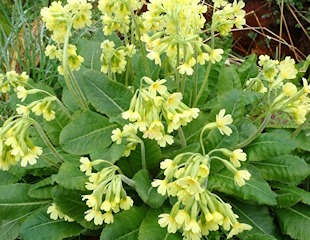
Primulas like to grow in moist soil, and many varieties, including Candelabra, are popular to grow by streams, in bog gardens and in semi-shade. Primulas are best grown in dappled shade in soil that is not prone to drying out.
Primula is a woodland plant and will benefit from a mulch of organic matter or leaf mould. Primula is a tough plant and will do well in most spots as long as it is not too dry or baking in the hot sun. If, as is sometimes the case, the leaves get a bit discoloured, brown at the edges, just snip them off. Dead-heading will help to keep the plant flowering.
The simple cowslip, Primula veris image left, looks lovely in a natural setting and will colonise a bank, forming clumps. Primula self-seeds near the mother plant, and it is easy to dig up the little seedling and grow it on or discard it, depending on requirements.
Primula looks good planted en mass together, and with spring-flowering bulbs. The later flowering varieties, such as Candelabra are ideal with Geraniums and Geum as shown in the images below right.
Crocus has over 40 varieties of Primula for sale, including the native primrose P. veris. (affiliate links) Most primulas are herbaceous or semi-evergreen perennials.
Different Types of Primula for Your Garden
Primula vulgaris, the common primrose
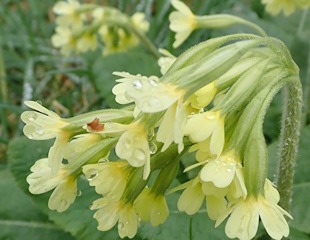
Primroses have pretty, delicate yellow flowers, blooming in early spring. Grow in sun or partial shade. Primroses are tolerant of most soil conditions, including damp soils. I took this image of Primroses growing on a bank streamside in my garden, and within a few years had colonised the area, making a lovely spring display.
Primrose provides early nectar and is also a food plant for larvae of the rare Duke of Burgundy butterfly.
Drumstick primula (Primula Denticulata)
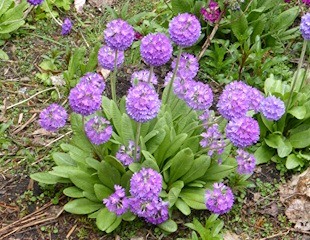
Illustrated is P. denticulata, which, as its name suggests, looks like a 'drumstick'. It is early-flowering and a popular Primula to mix with spring bulbs.
It is easy to grow and fully hardy. Grow in sun or partial shade and in any soil not too wet. Most bloom in shades of mauve, blue, white and cerise.
Drumstick primula has nectar/pollen-rich flowers, which are attractive to bees.
Candelabra Primula
Harlow Car hybrids
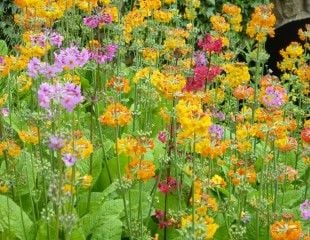
The tallest of the Primula family, P. candelabra, grows to around 60cms. One of the most well-known is the Harlow Carr hybrids, which flower from April to June in beautiful shades of orange, purple, pink and yellow.
This variety of primula is definitely well-suited to growing streamside and in boggy areas. At Harlow Carr, I took this image next to the stream where someone had planted these primulas in mass, and they looked lovely.
Polyanthus
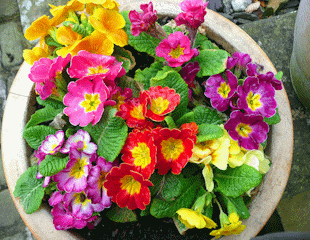
This Polyanthus is a hybrid of P. vulgaris (Primrose) and P. veris (Cowslip), often treated as bedding plants. In fact, they are perennial and will return the following year, especially if planted in favourable conditions. Although Polyanthus are perennials in reality, most gardeners will persuade them into flower for only 3/4/5 years, after which they may look a tad tired and have few flowers.
Primroses in natural setting

Primroses left undisturbed will multiply and colonise an area.
Our Native primrose is often seen on shady banks, woodlands and graveyards.
Primroses flower from January to May and are one of our loveliest native plants. Good for early pollinators, they look lovely with pulmonaria and early flowering violets.
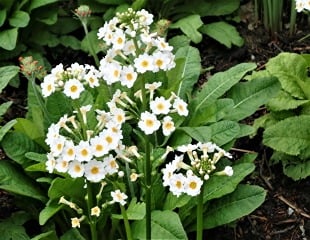
White candelabra primula
